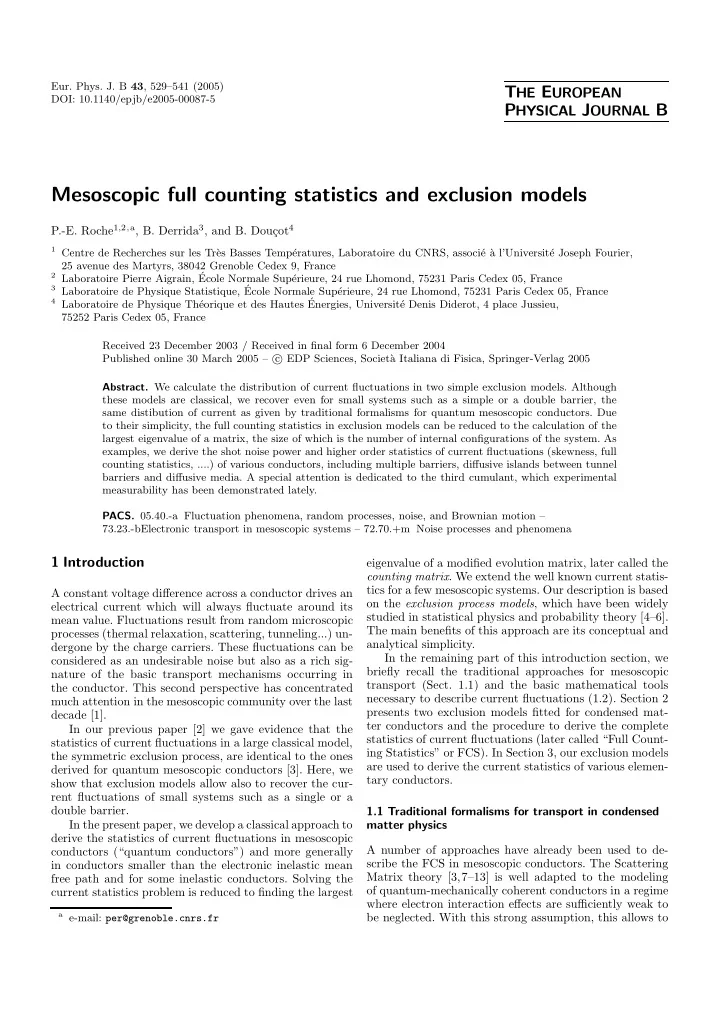

Eur. Phys. J. B 43 , 529–541 (2005) T HE E UROPEAN DOI: 10.1140/epjb/e2005-00087-5 P HYSICAL J OURNAL B Mesoscopic full counting statistics and exclusion models P.-E. Roche 1 , 2 , a , B. Derrida 3 , and B. Dou¸ cot 4 1 Centre de Recherches sur les Tr` es Basses Temp´ eratures, Laboratoire du CNRS, associ´ e ` a l’Universit´ e Joseph Fourier, 25 avenue des Martyrs, 38042 Grenoble Cedex 9, France 2 Laboratoire Pierre Aigrain, ´ Ecole Normale Sup´ erieure, 24 rue Lhomond, 75231 Paris Cedex 05, France 3 Laboratoire de Physique Statistique, ´ Ecole Normale Sup´ erieure, 24 rue Lhomond, 75231 Paris Cedex 05, France 4 Laboratoire de Physique Th´ eorique et des Hautes ´ Energies, Universit´ e Denis Diderot, 4 place Jussieu, 75252 Paris Cedex 05, France Received 23 December 2003 / Received in final form 6 December 2004 Published online 30 March 2005 – c � EDP Sciences, Societ` a Italiana di Fisica, Springer-Verlag 2005 Abstract. We calculate the distribution of current fluctuations in two simple exclusion models. Although these models are classical, we recover even for small systems such as a simple or a double barrier, the same distibution of current as given by traditional formalisms for quantum mesoscopic conductors. Due to their simplicity, the full counting statistics in exclusion models can be reduced to the calculation of the largest eigenvalue of a matrix, the size of which is the number of internal configurations of the system. As examples, we derive the shot noise power and higher order statistics of current fluctuations (skewness, full counting statistics, ....) of various conductors, including multiple barriers, diffusive islands between tunnel barriers and diffusive media. A special attention is dedicated to the third cumulant, which experimental measurability has been demonstrated lately. PACS. 05.40.-a Fluctuation phenomena, random processes, noise, and Brownian motion – 73.23.-bElectronic transport in mesoscopic systems – 72.70.+m Noise processes and phenomena 1 Introduction eigenvalue of a modified evolution matrix, later called the counting matrix . We extend the well known current statis- tics for a few mesoscopic systems. Our description is based A constant voltage difference across a conductor drives an on the exclusion process models , which have been widely electrical current which will always fluctuate around its studied in statistical physics and probability theory [4–6]. mean value. Fluctuations result from random microscopic The main benefits of this approach are its conceptual and processes (thermal relaxation, scattering, tunneling...) un- analytical simplicity. dergone by the charge carriers. These fluctuations can be In the remaining part of this introduction section, we considered as an undesirable noise but also as a rich sig- briefly recall the traditional approaches for mesoscopic nature of the basic transport mechanisms occurring in transport (Sect. 1.1) and the basic mathematical tools the conductor. This second perspective has concentrated necessary to describe current fluctuations (1.2). Section 2 much attention in the mesoscopic community over the last presents two exclusion models fitted for condensed mat- decade [1]. ter conductors and the procedure to derive the complete In our previous paper [2] we gave evidence that the statistics of current fluctuations (later called “Full Count- statistics of current fluctuations in a large classical model, ing Statistics” or FCS). In Section 3, our exclusion models the symmetric exclusion process, are identical to the ones are used to derive the current statistics of various elemen- derived for quantum mesoscopic conductors [3]. Here, we tary conductors. show that exclusion models allow also to recover the cur- rent fluctuations of small systems such as a single or a double barrier. 1.1 Traditional formalisms for transport in condensed In the present paper, we develop a classical approach to matter physics derive the statistics of current fluctuations in mesoscopic A number of approaches have already been used to de- conductors (“quantum conductors”) and more generally scribe the FCS in mesoscopic conductors. The Scattering in conductors smaller than the electronic inelastic mean Matrix theory [3,7–13] is well adapted to the modeling free path and for some inelastic conductors. Solving the of quantum-mechanically coherent conductors in a regime current statistics problem is reduced to finding the largest where electron interaction effects are sufficiently weak to a e-mail: per@grenoble.cnrs.fr be neglected. With this strong assumption, this allows to
Recommend
More recommend